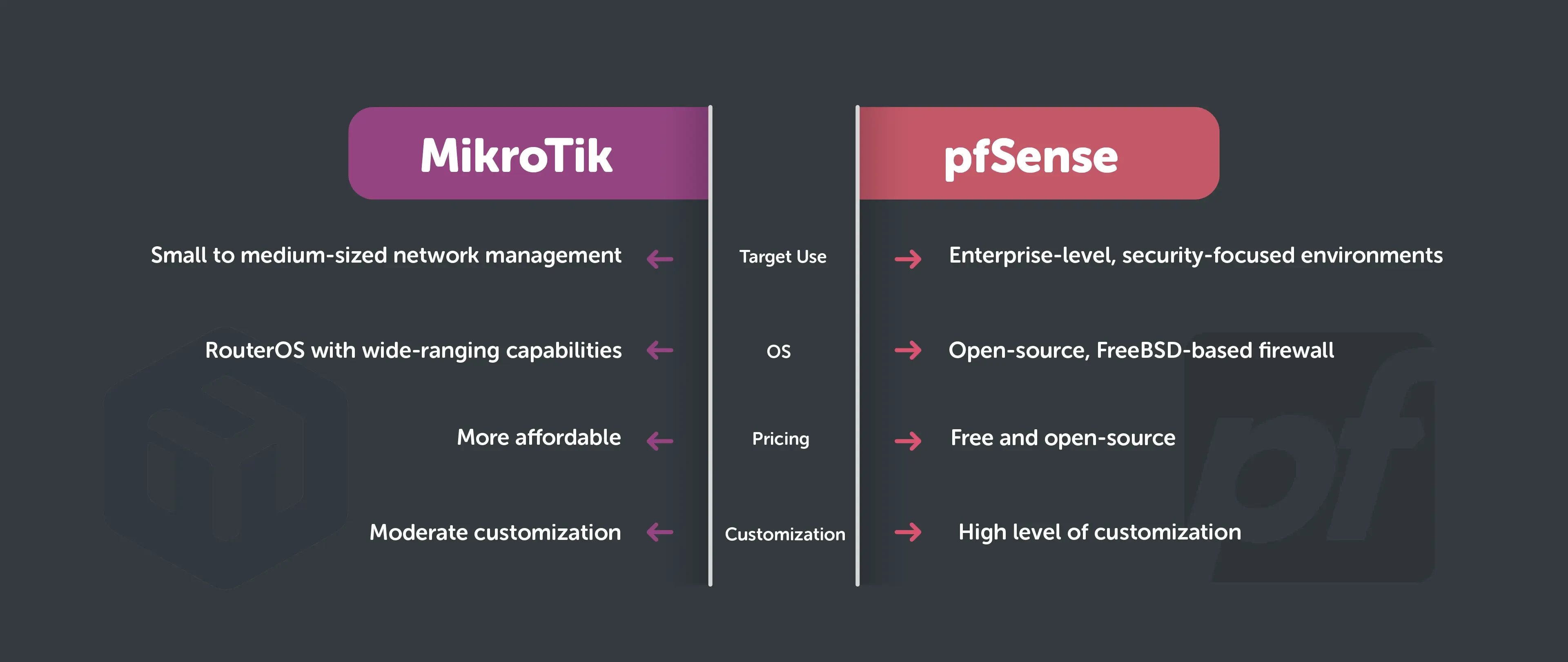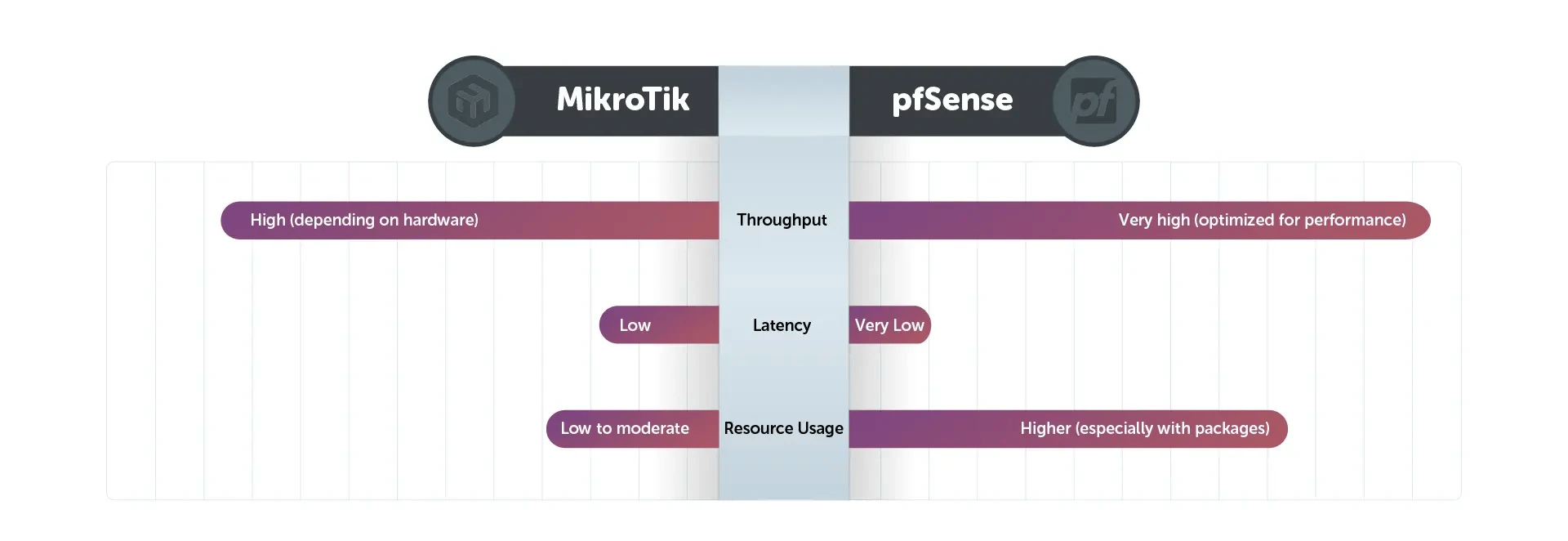When comparing MikroTik vs pfSense, both stand out as powerful solutions for network management, but each caters to different user needs. The MikroTik vs pfSense firewall debate often centers around functionality and ease of use. MikroTik, powered by RouterOS, is known for its flexibility and affordability, making it a popular choice among businesses and network enthusiasts. On the other hand, pfSense is celebrated for its robust security features and open-source nature. Evaluating MikroTik vs pfSense performance, pfSense typically excels in complex security scenarios, while MikroTik performs efficiently in routing tasks. The MikroTik vs pfSense comparison highlights RouterOS's scalability and pfSense's advanced packet filtering capabilities. For advanced users, the choice between MikroTik RouterOS vs pfSense often depends on specific requirements like customization or hardware support. Exploring pfsense vs mikrotik performance reveals distinct strengths in different network setups. Ultimately, the MikroTik firewall vs pfSense decision boils down to use case priorities. If You need MikcroTik, visit MikroTik VPS.
What is Mikrotik?
MikroTik is a Latvian company that specializes in producing network hardware and software, including routers, switches, and wireless systems. At the heart of MikroTik’s offerings is its proprietary operating system, RouterOS, which is pre-installed on its hardware and also available for standalone installation on x86-based systems. RouterOS provides advanced network management features, including routing, bandwidth control, VPN capabilities, hotspot functionality, and a built-in firewall. The platform is well-suited for both home users and enterprise networks, making it a versatile solution in the networking world.

When comparing MikroTik vs pfSense, a few distinctions emerge, particularly in their core capabilities and target audiences. MikroTik excels in routing and wireless networking, often favored for its cost-effectiveness and compact hardware solutions. However, the MikroTik vs pfSense firewall comparison shows that pfSense is often considered superior in terms of security features, with a focus on robust packet filtering and threat management.
For those exploring MikroTik OS vs pfSense, RouterOS shines in environments that prioritize affordability and flexibility in routing tasks, while pfSense appeals to users who need extensive customization and open-source transparency. These differences make the MikroTik vs pfSense debate relevant for anyone deciding on a network management tool that balances cost and performance.
The pfsense vs RouterOS evaluation often boils down to specific use cases. For example, pfSense is highly regarded for its intuitive web interface and wide plugin ecosystem, whereas RouterOS demands a steeper learning curve but offers unparalleled control for advanced users. While you can install pfSense on various platforms, attempts to install pfSense on MikroTik hardware are not straightforward due to RouterOS’s proprietary nature and the hardware’s locked design.
Additionally, the MikroTik vs pfSense vs router discussion emphasizes how each solution is positioned. MikroTik functions as an all-in-one networking device with a range of affordable routers, whereas pfSense relies on third-party hardware but delivers exceptional software flexibility. In broader comparisons like MikroTik vs Firewalla, MikroTik’s professional-grade features outshine consumer-focused alternatives like Firewalla.
Ultimately, the MikroTik Pfsense choice depends on network needs. Whether it’s for routing or security, both offer unique benefits that cater to diverse audiences. However, enterprises requiring robust firewalls often lean towards pfSense, while MikroTik’s hardware/software integration is ideal for cost-sensitive routing and wireless tasks.
What is pfsense?
pfSense is a free, open-source firewall and router platform based on FreeBSD, designed for powerful and flexible network management. Widely recognized for its robust security features and extensive customization options, pfSense is used by individuals, businesses, and enterprises alike. Its primary functionalities include stateful packet filtering, VPN support, intrusion detection and prevention, load balancing, and comprehensive traffic shaping. With an intuitive web-based interface, pfSense allows users to configure even complex networking setups with ease, making it one of the most accessible yet advanced firewall solutions available today.
In the context of MikroTik vs pfSense, pfSense is often favored for its focus on security and its ability to function as a dedicated firewall. Where MikroTik shines in affordability and routing performance, pfSense provides unparalleled depth in its firewall capabilities, making it a go-to solution for organizations prioritizing network protection. The MikroTik vs pfSense firewall comparison highlights pfSense’s advanced threat management tools, such as intrusion prevention systems (IPS) and content filtering, which give it an edge in safeguarding sensitive environments.
Exploring MikroTik vs pfSense also reveals differences in customization and scalability. pfSense thrives on its open-source model, offering users access to an extensive library of plugins and extensions that cater to specific networking needs. MikroTik, on the other hand, relies on its proprietary RouterOS, which delivers robust routing features but limits software flexibility. For users seeking software-driven solutions over hardware constraints, pfSense stands out in the MikroTik OS vs pfSense debate.
A notable point in the MikroTik vs pfSense comparison is pfSense’s versatility in deployment. While MikroTik offers integrated hardware/software solutions, pfSense runs on a variety of platforms, including commodity hardware, virtual machines, and cloud environments. This adaptability is particularly advantageous for users needing high-performance solutions without being tied to specific hardware.
pfSense also excels in enterprise-grade features such as high availability (HA), VPNs for secure remote access, and detailed logging for audits and troubleshooting. These capabilities set it apart in MikroTik vs pfSense scenarios where security is paramount.
Ultimately, the choice between MikroTik vs pfSense depends on your priorities. While MikroTik is ideal for cost-effective routing and wireless solutions, pfSense offers a feature-rich firewall and router solution that excels in security and customization for networks of any size.

Pros and Cons of Mikrotik
MikroTik is a versatile and affordable solution for network management, offering hardware and software tools like routers, switches, and its RouterOS operating system. While it is highly functional and scalable, it may not suit every use case. Here’s a detailed breakdown of its pros and cons, including a comparison with pfSense. You can know The Best MicroTik Switches, read The Best Mikrotik Switches.
Pros of MikroTik
1. Affordability
MikroTik’s hardware is priced competitively, making it accessible for small businesses and individuals.
|
Feature |
Details |
||||
|
|
||||
|
|
2. Advanced Routing Features
MikroTik excels in handling complex routing tasks.
|
|
||||
|
|
||||
|
|
3. Wireless Capabilities
MikroTik offers seamless integration of wired and wireless networks.
-
Built-in support for WiFi standards like 802.11ac and 802.11n.
-
Advanced wireless tools for signal optimization and interference reduction.
4. Customization with RouterOS
RouterOS provides an extensive feature set for power users.
|
|
||||
|
|
||||
|
|
5.Compact and Lightweight Devices
MikroTik hardware is known for its small footprint.
-
Easy to deploy in limited spaces.
-
Low power consumption, making it cost-efficient.
Cons of MikroTik
1. Steep Learning Curve
MikroTik's interface, especially RouterOS, can be challenging for beginners.
|
|
||||
|
|
||||
|
|
2. Limited Hardware Performance
Compared to enterprise-grade solutions, MikroTik hardware may not meet high-demand scenarios.
|
|
||||
|
|
||||
|
|
3. Security Concerns
Although MikroTik offers firewall features, its security capabilities are not as robust as pfSense.
|
|
||||
|
|
||||
|
MikroTik devices have faced high-profile security breaches. |
Pros And Cons of pfsense
pfSense is a powerful, open-source firewall and router platform built on FreeBSD. Known for its rich feature set and advanced security capabilities, pfSense caters to home users, small businesses, and enterprise environments alike. Below, we examine the pros and cons of pfSense in detail, highlighting its strengths and limitations, especially in comparison to MikroTik, using the MikroTik vs pfSense analysis where relevant.

Pros of pfSense
1. Advanced Firewall Capabilities
pfSense is renowned for its robust and customizable firewall features, outperforming MikroTik in security-focused setups.
|
|
||||
|
|
||||
|
|
||||
|
|
In the MikroTik vs pfSense firewall debate, pfSense offers a wider array of security tools, making it a better choice for environments requiring stringent protection.
2. Open-Source and Free
pfSense is open-source, offering enterprise-grade features without licensing fees.
|
|
||||
|
|
||||
|
|
While MikroTik's RouterOS requires paid licensing, pfSense is completely free, making it a cost-effective option for users with compatible hardware.
3. Hardware Flexibility
Unlike MikroTik, pfSense is not tied to proprietary hardware.
|
|
||||
|
|
||||
|
|
Users can build a powerful pfSense firewall using off-the-shelf components, enabling flexibility in performance and cost.
4. VPN Integration
pfSense supports multiple VPN protocols, making it a secure choice for remote connectivity.
|
|
||||
|
|
||||
|
|
||||
|
|
While both platforms offer VPN support, pfSense's implementation is more user-friendly and secure, particularly for complex setups.
5. Intuitive Web-Based Interface
pfSense provides a user-friendly interface, making network management accessible even for non-technical users.
-
Easy navigation for configuring firewalls, routing, and VPNs.
-
Built-in tools like dashboards, graphs, and logs simplify monitoring.
6. Scalability and Reliability
pfSense scales well with high-performance hardware, making it suitable for growing businesses.
|
|
||||
|
|
||||
|
Ensures uptime with CARP failover and state synchronization. |
Cons of pfSense
1. Steep Learning Curve for Advanced Features
While the interface is intuitive, mastering pfSense’s advanced features requires technical expertise.
|
|
||||
|
|
||||
|
Community-driven but sometimes lacks clear, step-by-step guides. |
2. Hardware Requirements
pfSense requires external hardware, which can increase initial costs compared to MikroTik’s integrated hardware/software solutions.
|
|
||||
|
|
||||
|
|
MikroTik’s all-in-one devices offer a plug-and-play solution, whereas pfSense demands careful hardware selection.
3. Limited Wireless Functionality
Unlike MikroTik, pfSense does not natively support advanced wireless features.
|
|
||||
|
No integrated WiFi tools |
Requires external access points for wireless networks. |
||||
|
Unlike MikroTik, pfSense does not support these out of the box. |
4. Cost of High-Performance Hardware
While pfSense itself is free, enterprise-grade setups can be costly.
|
Details |
||||
|
|
||||
|
Paid support options add to operational costs. |
pfSense’s strengths lie in its robust firewall, extensive VPN capabilities, and open-source nature. While it demands more technical expertise and hardware investment than MikroTik, it shines in environments where security and scalability are paramount.

Similarity Between pfsense vs mikrotik

MikroTik and pfSense are two of the most popular solutions for network management, offering robust features for routing, firewalling, and VPN connectivity. Despite their differences in architecture and implementation, they share several similarities that make them attractive to users seeking cost-effective and customizable solutions. This detailed analysis will explore their advantages and disadvantages while maintaining a focus on the MikroTik vs pfSense comparison to highlight their shared capabilities.
1. Shared Advantage: Versatility in Network Management
Both MikroTik and pfSense are versatile platforms capable of managing complex network configurations.
MikroTik Features
-
MikroTik's RouterOS provides tools for routing, firewalling, bandwidth management, and wireless access.
-
Its all-in-one design is suited for small to medium-sized businesses requiring seamless integration between hardware and software.
pfSense Features
-
Built on FreeBSD, pfSense offers advanced network management features, including high availability, traffic shaping, and VPN support.
-
It is hardware-independent, allowing users to deploy it on a wide variety of devices.
MikroTik vs pfSense
-
Both platforms excel in providing routing and firewall capabilities, making them comparable in terms of versatility.
Example:
In scenarios where businesses need robust routing capabilities, both MikroTik and pfSense deliver reliable options, with MikroTik’s integrated hardware standing out for convenience and pfSense excelling in flexibility.
2. Shared Advantage: Cost-Effectiveness
Both MikroTik and pfSense are known for being cost-efficient solutions compared to enterprise-grade alternatives like Cisco or Fortinet.
MikroTik’s Cost Efficiency
-
MikroTik offers affordable hardware with built-in RouterOS licenses.
-
Its ready-to-use devices make deployment easier and reduce setup costs.
pfSense’s Cost Efficiency
-
pfSense software is open-source and free, requiring only hardware costs.
-
It enables users to repurpose old hardware, lowering the barrier to entry.
MikroTik vs pfSense Comparison
-
MikroTik provides cost-effective hardware/software bundles, whereas pfSense allows for greater flexibility by being open-source.
3. Shared Advantage: Comprehensive Firewall Capabilities
Firewalls are central to both MikroTik and pfSense, offering robust solutions for traffic management and security.
|
MikroTik |
pfSense |
||
|
Supports filtering with simple and advanced rules. |
Granular rule creation with NAT, stateful filtering. |
||
|
Security Features |
|
Built-in IDS/IPS with Snort/Suricata support. |
||
|
Ease of Configuration |
Requires CLI or WinBox GUI. |
Web-based GUI simplifies management. |
Both platforms enable effective firewall management, but pfSense offers more advanced tools for intrusion detection and prevention.
Shared Advantage: VPN Support
Both platforms provide robust VPN solutions, critical for secure remote access and site-to-site connectivity.
MikroTik VPN Features
-
Supports protocols like PPTP, L2TP/IPsec, and OpenVPN.
-
Its integration with RouterOS allows for straightforward configuration.
pfSense VPN Features
-
Supports a wider range of VPN protocols, including OpenVPN, IPsec, and WireGuard.
-
Offers advanced VPN management features like traffic shaping over VPN tunnels.
MikroTik vs pfSense Performance
-
While both platforms support VPNs, pfSense provides better scalability and performance for enterprise-grade deployments, whereas MikroTik is sufficient for small-scale use.
5. Shared Advantage: Active Community Support
Both MikroTik and pfSense enjoy strong community backing, ensuring regular updates and abundant troubleshooting resources.
MikroTik Community
-
A large user base actively participates in forums and provides tutorials.
-
MikroTik’s support team also contributes to resolving common issues.
pfSense Community
-
pfSense benefits from an open-source community, ensuring frequent updates and comprehensive documentation.
-
Paid support options are also available for enterprises.
MikroTik vs pfSense Comparison
-
Both platforms rely on their communities for growth and support, making them equally reliable for users seeking guidance.
6. Shared Disadvantage: Steep Learning Curve for Beginners
Despite their advantages, both MikroTik and pfSense can be challenging for newcomers to master.
|
|
|
||||||
|
Initial Configuration |
CLI and WinBox require networking expertise. |
Web GUI simplifies setup but advanced features are complex. |
||||||
|
Advanced Features |
Complex for non-technical users. |
Demands knowledge of networking concepts. |
||||||
|
Documentation |
Comprehensive but technical. |
Community-driven, sometimes inconsistent. |
MikroTik requires more technical expertise for initial configuration, while pfSense’s intuitive GUI makes basic setup easier, although its advanced features still present challenges.
7. Shared Disadvantage: Limited Wireless Capabilities
Both platforms require additional hardware for robust wireless network management.
MikroTik Wireless
Built-in wireless support is limited to MikroTik devices with WiFi capability.
Advanced wireless management requires proprietary MikroTik hardware.
pfSense Wireless
Lacks built-in wireless functionality and relies on external access points.
Wireless performance depends heavily on compatible hardware.
MikroTik vs pfSense Performance
MikroTik has the edge in wireless capabilities when using its integrated hardware, but both platforms are limited compared to dedicated wireless solutions.
The MikroTik vs pfSense comparison highlights their shared strengths in cost-efficiency, firewall management, and VPN capabilities, as well as mutual challenges such as a steep learning curve and limited wireless functionality. Both platforms are powerful in their own right, making the choice between them depend on specific use cases:
-
Choose MikroTik for integrated hardware/software solutions that are ready to deploy out of the box.
-
Opt for pfSense when customization and advanced security are priorities.
Ultimately, whether you choose MikroTik or pfSense, their shared advantages ensure that either platform will meet the needs of most network management tasks efficiently.

Mikrotik vs pfsense: Main Differences
Hardware and Deployment
One of the most significant differences between MikroTik and pfSense lies in their hardware requirements and deployment flexibility. If You want to compare between Ubiquiti and MikroTik, read Ubiquiti vs. MikroTik or Cisco and MikroTik, read Cisco vs. MikroTik.
|
MikroTik |
|
||||
|
Hardware Type |
Proprietary routers with RouterOS pre-installed. |
Hardware-agnostic; runs on x86 or ARM hardware. |
||||
|
Setup Time |
Ready-to-use devices with minimal setup. |
Requires installation on hardware, longer setup. |
||||
|
Scalability |
Limited to MikroTik’s hardware capabilities. |
Scalable; depends on user-chosen hardware specs. |
While MikroTik offers plug-and-play convenience, pfSense’s hardware-agnostic approach allows for greater customization and scalability.
3. User Interface and Ease of Use
User-friendliness is a key consideration when choosing between MikroTik vs pfSense, especially for beginners or advanced users.
|
Aspect |
MikroTik |
pfSense |
|
Graphical User Interface (GUI) |
WinBox GUI and WebFig for configuration. |
Web-based GUI with advanced options. |
|
Command-Line Interface (CLI) |
Accessible but requires technical expertise. |
Intuitive CLI with FreeBSD commands. |
|
Ease of Configuration |
Simplified for basic setups but steep for advanced. |
More intuitive for basic and advanced configurations. |
· MikroTik's WinBox is useful but can feel limited compared to pfSense’s modern web GUI.
· pfSense simplifies managing complex network setups with an intuitive interface.
4. Routing and Firewall Capabilities
Routing and firewalling are core functionalities where MikroTik vs pfSense diverge significantly in approach and performance.
MikroTik Routing and Firewall
-
Offers advanced routing protocols (OSPF, BGP, MPLS).
-
Firewall rules are powerful but require manual configuration.
pfSense Routing and Firewall
-
Supports static and dynamic routing, though less extensive than MikroTik.
-
Built-in IDS/IPS (Snort, Suricata) enhances firewall functionality.
|
|
pfSense |
||||
|
Firewall Management |
Rule-based; effective for simple and advanced needs. |
Advanced, with integrated IDS/IPS. |
||||
|
Dynamic Routing Protocols |
Extensive, suited for ISP-level routing. |
Limited to OSPF and RIP. |
||||
|
Traffic Management |
Bandwidth control through Queue Tree. |
Traffic shaping with flexible rules. |
· pfSense offers superior security features with integrated IDS/IPS, while MikroTik excels in advanced routing.
5. VPN Capabilities
VPN support is another crucial difference between MikroTik vs pfSense.
|
|
|
||||||
|
Protocols Supported |
PPTP, L2TP/IPsec, OpenVPN. |
OpenVPN, IPsec, WireGuard. |
||||||
|
Ease of Configuration |
Basic protocols are easier to set up. |
Advanced VPN configurations available. |
||||||
|
Scalability |
Suitable for small setups. |
Better suited for large-scale VPNs. |
-
pfSense is better for enterprise-level VPN setups due to its protocol variety and scalability. If You need guid to Config OpenVPN on MikroTik routers, read OpenVPN Configuration on MikroTik Routers.
6. Cost Considerations
Cost plays a significant role in the MikroTik vs pfSense debate, as they cater to different pricing models.
|
|
|
||||||
|
Initial Investment |
Affordable hardware bundles. |
Free software; variable hardware costs. |
||||||
|
License Fees |
RouterOS license included in hardware cost. |
No license fees for pfSense software. |
||||||
|
Long-Term Costs |
Minimal; hardware upgrades may be required. |
Depends on chosen hardware upgrades. |
7. Scalability and Enterprise Use
For larger deployments, scalability is essential, and this is where the MikroTik vs pfSense comparison showcases distinct differences.
MikroTik Scalability
-
Suitable for small to medium-sized businesses.
-
Limited by proprietary hardware specifications.
pfSense Scalability
-
Well-suited for enterprise-level deployments.
-
Flexible hardware choices enable better scalability.
8. Customization and Flexibility
|
|
|
||||||
|
|
|
||||||
|
Third-Party Integration |
Limited support for external tools. |
Supports plugins and packages (Snort, Squid). |
· pfSense’s open-source nature makes it more adaptable, while MikroTik’s limitations make it better for out-of-the-box use.
9. Reliability and Support
|
|
|
||||||
|
Community Support |
Active forums and tutorials. |
|
||||||
|
Paid Support |
|
Enterprise support plans available. |

General Comparison Table
|
|
|
||||||
|
Ease of Use |
Moderate, with WinBox GUI. |
Beginner-friendly web GUI. |
||||||
|
Hardware Flexibility |
Proprietary hardware only. |
Flexible; runs on any compatible hardware. |
||||||
|
Firewall Features |
Basic to advanced rule-based filtering. |
Advanced with IDS/IPS integration. |
||||||
|
Cost |
Affordable with hardware included. |
Free software, variable hardware cost. |
||||||
|
VPN Support |
Basic protocols supported. |
Wide range, including WireGuard. |
The MikroTik vs pfSense debate boils down to individual needs and preferences:
-
Choose MikroTik if you require cost-effective, ready-to-use hardware with advanced routing capabilities.
-
Choose pfSense if flexibility, enterprise scalability, and advanced security features are your priorities.
By understanding their main differences, users can make informed decisions to optimize their network setups.

Conclusion
The MikroTik vs pfSense comparison highlights two powerful networking solutions, each catering to distinct user needs. MikroTik excels in affordability, simplicity, and hardware integration, making it ideal for small to medium-sized businesses and users seeking a cost-effective, plug-and-play solution. On the other hand, pfSense offers unmatched flexibility, scalability, and advanced security features due to its open-source nature, making it a preferred choice for enterprise-level deployments and highly customized network environments. While MikroTik's proprietary hardware limits customization, its advanced routing capabilities and efficient performance shine in ISP and SMB use cases. Conversely, pfSense’s hardware-agnostic approach and robust VPN, firewall, and third-party integration options make it suitable for complex and secure networks. Ultimately, the choice between MikroTik vs pfSense depends on the specific requirements of your network, balancing factors like budget, scalability, ease of use, and advanced feature demands to achieve optimal results.
People also read:










